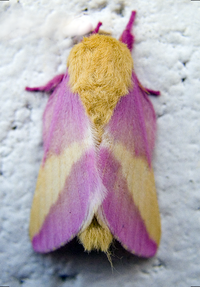- Dryocampa rubicunda
-
Rosy maple moth 
Scientific classification Kingdom: Animalia Phylum: Arthropoda Class: Insecta Order: Lepidoptera Family: Saturniidae Genus: Dryocampa Species: D. rubicunda Binomial name Dryocampa rubicunda
(Fabricius, 1793)The Rosy Maple Moth (Dryocampa rubicunda) is a North American moth in the Saturniidae family. Males have a wingspan of 32–44 mm; females of 40–50 mm. They have reddish-to-pink legs and antennae, yellow bodies and hindwings, and pink forewings with a triangular yellow band across the middle. Males have bushier antennae than females. As the name implies, rosy maple moths mainly feed on Maples, particularly Red Maple, Silver Maple, and Sugar Maple. Sometimes these moths become pests on maple trees.
Life cycle
Females lay pale yellow eggs in clusters of 20-30 on the undersides of maple leaves. After about two weeks, small gregarious caterpillars hatch. They will remain gregarious through the third instar, but the final two are solitary. The mature larvae are light green with black lateral lines, red heads, and two filaments behind the head, and reach lengths of about 55 mm. When they are ready, they climb to the bottom of the host tree and pupate in shallow underground chambers. The pupae are very dark, elongated, and have small spines. The pupa ends in a small forked point. When the imago (adult) ecloses, it has small wings which it has to pump full of fluid in order for them to expand and allow for flight. Adult moths are generally nocturnal; they preferentially fly throughout the first third of the night (Fullard & Napoleone 2001). The females emit pheromones at night and attract males, which have bushier antennae to detect the pheromones.
References
- Fullard, James H. & Napoleone, Nadia (2001): Diel flight periodicity and the evolution of auditory defences in the Macrolepidoptera. Animal Behaviour 62(2): 349–368. doi:10.1006/anbe.2001.1753 PDF fulltext
External links
Categories:
Wikimedia Foundation. 2010.
